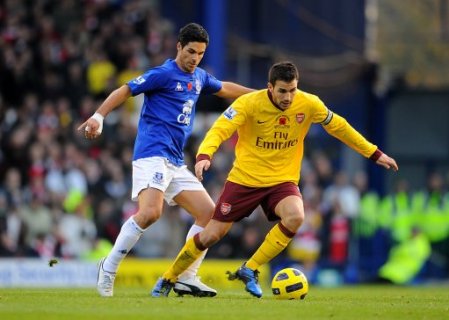
Mikel Arteta took a £20,000 per week cut to fill Fabregas’s shoes
A few things have shaken out this summer. The inability of Arsenal to hold onto their marquee players who overtly cite the lack of titles as their reason for moving on while also negotiating better personal terms with their new owners seems to be the new reality. Arsenal’s restrictive wage structure in this free market economy is seen as a liability as they bleed players to clubs who pony up without ceilings.
Arsenal could have rebuilt the squad with players of equal quality dipping into the deep pool of talent in the French and Spanish leagues by paying market prices.
Signings like Yann M’Villa, Eden Hazard, Marvin Martin would provide an instant imprimatur from the sales of Fabregas and Samir Nasri but as yet remain figments in the fan’s imagination. In other instances Arsenal under bid seriously to take them out of contention as in Phil Jagielka and Gary Cahill’s case. There is enough evidence to suggest that Arsenal blinked in the race to acquire Phil Jones and Juan Mata ceding to sides with more appetite and cash. Such examples show that Arsenal have scaled even further back in their frugality.
These two forces are shaping the way for a change in the way Arsenal remain competitive.
Arsene Wenger’s efforts to augment from the reserves has led to the advent of Jack Wilshere, Aaron Ramsey, and Emmanuel Frimpong. He has added to that list some raw and untested talent in Alex Oxlade- Chamberlain, Ryo Miyaichi, and Carl Jenkinson. These are time tested Wenger moves and in any other summer would not have raised eyebrows but given the duress that Arsenal find themselves in have been recruited straight to the first team. Martin Keown’s thoughtful opinion piece laments Wenger’s unwelcome trend towards spurning loans seen as essential to a young player’s development which formed a bulwark of Arsenal’s past success. The reliance on greenhorns some of it unavoidable resulted in Arsenal’s most humiliating defeat in 115 years at the hands of Utd last weekend.
The big talking point was how Arsenal conducted business in the last days of the transfer period. It is clear the signings of players who would at best be third or fourth choices if that show a club in damage control mode.
The frenetic last minute nature is geared up for a classic run at fourth spot for Champions League purposes after a disastrous start to their season. What is less obvious is these signings are also a tacit sign of Arsenal’s exploration into the market for cut rate off their prime players who might be looking for a move. They find a sanctuary in the transfer deadline.
Under Wenger this end has received scant and fitful attention confined to defensive personnel but the deliberate nature of these spate of signings reflect the hand of the board. The MLS is well represented in Arsenal in the form of Ivan Gazidis, the managing director and Stan Kroenke, majority owner of the club.
Gazidis a former MLS deputy commissioner and Kroenke, is the owner of the Colorado Rapids, last years league champions are well versed in how the MLS operates. Gazidis served under Don Gerber, the present MLS commissioner whose endeavours to stop the perception of the MLS as retirement haven include introducing marketing measures such as the DP status which works around the salary cap to pay for still competitive players. It paved the way for a steady trickle of marquees like David Beckham, Thierry Henry, Freddie Ljungberg, Rafa Marquez, Guillermo Baretto Schelotto, Torsten Frings and Robbie Keane.
Arsenal have their own self imposed salary cap which rarely exceeds £90,000 per week (Fabregas, RVP, and Song are exceptions). Nasri came up against this glass ceiling where he would be limited to earning £4.7m per annum which is what Beckham is being paid at the Galaxy. The difference is Nasri and Fabregas are contemporaneous peers of the game while Beckham older by 10 years can no longer compete at that level. Nasri was earning £60,000/week at Arsenal before moving to City for triple that amount.
The more representative salary for an Arsenal player falls between £30,000/week and £60,000/week which is what Landon Donovan (29 years) and Rafa Marquez (31 years) receive at the MLS. Donovan not two years ago was an Everton prospect and Marquez was part of the Barca back four till injury and loss of form capped his Catalunyan career. One can argue that playing for Arsenal brings rewards that should have little to do with salary but if 4th place is its self described pinnacle then there is less to distinguish it from a less aspirational league.
There are parallels to Arsenal’s last day spree. We can argue that Mikel Arteta at 29 years of age still represents very good value for £10m and his signing came as a great relief but he’s about 5 years beyond having a side built around him. In fact, Arsenal are paying Arteta £20,000 less than he was getting at cash strapped Everton. The Spaniard’s decision was driven by his first ever chance at Champions League representation.
Yossi Benayoun at 31 years, undoubtedly clever and creative, has been slowed by injury and age. Per Mertesacker (26 years), Park Chu Young (26 years), and Andre Dos Santos (28 years) came to Arsenal virtually uncontested for their signatures as younger rivals push for their spots at their former abodes. For some of them Arsenal represents the final stop.
The fact is that City, Barca, Utd, Real, and Chelsea will continue to steal the cream of the crop with their title aspirations and wage on steroids. Wenger will hope his emphasis on talent pays off but a transition to an Ivan Campo type of graying demographic might be in the cards for Arsenal as pragmatic concerns rule the day.